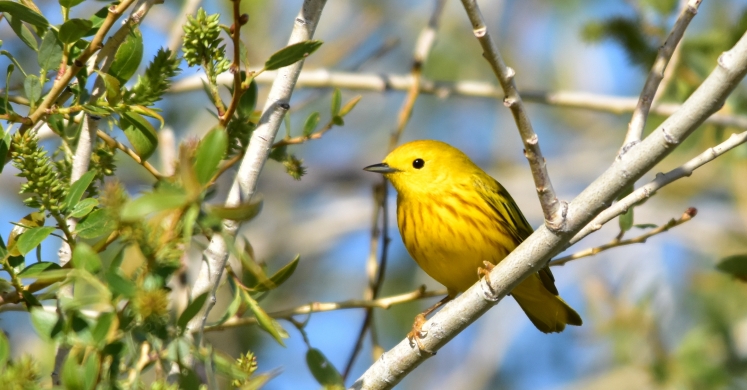Blog

#bioPGH Blog: Yellow Warblers
 A resource of Biophilia: Pittsburgh, #bioPGH is a weekly blog and social media series that aims to encourage both children and adults to reconnect with nature and enjoy what each of our distinctive seasons has to offer.
A resource of Biophilia: Pittsburgh, #bioPGH is a weekly blog and social media series that aims to encourage both children and adults to reconnect with nature and enjoy what each of our distinctive seasons has to offer.
I heard the distinctive, quick-paced call as I headed to my car one morning: sweet, sweet, sweet, oh-so-sweet...sweet, sweet, sweet, oh-so-sweet! My eyes scanned the developed landscape, searching for a tell-tale flash of yellow. A classic Pittsburgh neighborhood built into a hillside, with few trees and no wetland in sight, the area isn’t the best yellow warbler habitat; but we at least had one visiting! I never actually saw the yellow warbler, whose song seemed to come from a brushy thicket on the steep hillside, but it was a good reminder of being in nature even in the midst of the bustling, built environment. Let’s explore that little bird in more depth, shall we?
Yellow warblers (Setophaga petechia) are a part of the larger group called New World warblers of the family Parulidae. New birders can find many of these species difficult to identify in the field (and that includes me!), but the yellow warbler is distinctive with its bright yellow coloration. Like many other warblers, yellow warblers are insectivores, with a large portion of their diet made up of caterpillars. They are relatively small birds—adults only weigh about 8-10 grams, roughly the weight of two quarters—and since they are migratory, we will only see them here in Pennsylvania during the spring and summer breeding season.
In addition to their bright, cheerful color, yellow warblers are also classically known for their “sweet” song (which birders remember with the mnemonic sweet, sweet, sweet, oh-so-sweet that I mentioned earlier). You can listen below to a few different examples.
Don’t be fooled by a yellow warbler’s bright color and sweet song—they are shrewd defenders of their nests. Besides performing distraction displays to lure predators away from their nests, yellow warblers have been known to swoop and strike at potential predators, and they even react specifically to different threats against their eggs or nestlings. One study noted that warblers responded to mammalian predators (e.g. squirrels) by performing distraction behaviors to lure the predator away from the nest, but the warblers tended to both perform distraction behaviors and vocalize at avian predators like grackles.
Yellow warblers’ defense against brood parasitism is particularly intriguing though. Do you remember when we talked about cowbirds here on the blog? Cowbirds are brood parasites, meaning they lay their own eggs in the nests of other bird species, leaving those parents to raise their young. Yellow warblers defend their nests from cowbirds specifically by making sharp alarm calls and rushing back to the nest to sit on it, thus defending it from a would-be egg layer. If they do find a cowbird egg in the nest, though, yellow warblers will often just give up their current eggs, build a new nest on top of the previous one, and then lay a brand-new clutch of eggs—an uncommon strategy in the bird world.
Notably, whether yellow warblers are defending their nests from predators or brood parasites, they will spend the most energy on defense at the stage that it is most advantageous for them to do so. If a cowbird appears near the nest during egg-laying and incubation stage, yellow warblers will react defensively towards the cowbird—as though they are aware that their nest is most vulnerable to a brood parasite. They respond less strongly to the presence of cowbirds after their eggs have hatched. However, yellow warblers react more strongly to the presence of predator species after their eggs have hatched than during incubation, apparently aware that the threat of predation from some species is stronger for nestlings than eggs.
Isn’t it exciting how there is always so much more to nature than meets the eye? Even a tiny bird can have a suite of defense strategies ready to protect their nests. All the more reason to get outdoors, keep learning, and keep exploring!
Connecting to the Outdoors Tip: Yellow warblers favor wooded habitats near wetlands or streams, or at the edges of forest. In the Pittsburgh area, Schenley Park and Frick Park are yellow warbler hot spots, and you can check out recent sightings of yellow warblers on eBird.
Resources
Cornell Lab of Ornithology: Yellow Warbler
Images: cover, USFWS Public Domain; Header, Pexels CC0

